Swordtail fish, distinguished by their long, sword-like tails, are a colourful and lively addition to any home aquarium. Native to Central and North America, these freshwater species are renowned for their hardy nature and easy care requirements, making them ideal for both beginner and experienced aquarists.
The swordtail’s playful behaviour and vibrant hues, ranging from greens and reds to yellows, offer endless fascination. Additionally, they’re livebearers, which adds an exciting dimension to fish keeping as you might get to witness the miracle of birth right in your tank. A proper understanding of their needs, from diet to tank conditions and compatible mates, is crucial for their thriving existence.
Table of Contents
Swordtail Fish: Facts & Overview
| Swordtail Fish Fact | Details |
| Scientific Name: | Xiphophorus hellerii |
| Care Level: | Easy to Moderate |
| Native Region: | Central and North America |
| Lifespan: | 3–5 years, up to 5+ years in optimal conditions |
| Size: | Up to 5–6 inches (approximately 13–15 cm) |
| Family: | Poeciliidae |
| Diet: | Omnivore |
| Minimum Tank Size: | 76 litres (approximately 20 gallons) for a single fish |
| Compatibility: | Compatible with a variety of non-aggressive, similarly-sized species |
Origin
The Swordtail fish, scientifically known as Xiphophorus hellerii, originates from the warm waters of Central and North America, with a significant presence in Mexico and Honduras. They inhabit a wide range of freshwater habitats, from rapid flowing rivers to slow-moving streams, often amidst dense vegetation.
Their natural environment plays a crucial role in defining their care needs in home aquariums, especially in terms of water temperature, pH balance, and tank setup. The swordtails we see today in aquariums, bearing a variety of vibrant colours and patterns, are often the result of careful selective breeding, a departure from their wild counterparts that usually exhibit a more subdued green hue.
Swordtail Fish Appearance
Colours, Patterns, Fins
Swordtail fish are celebrated in the aquarium world for their diverse range of colours, patterns, and distinct fin shapes. They possess an elongated body and a signature ‘sword-like’ tail, particularly prominent in males.
The colours of Swordtail fish can range extensively due to selective breeding. While wild Swordtails are usually greenish with a brown or yellow lateral stripe, aquarium varieties exhibit a wide palette, including red, orange, black, white, and even multicoloured or marbled patterns.
Their body can be uniformly coloured or bear distinct patterns, such as spots or stripes. Some Swordtail fish may also display a ‘wagtail’ pattern, where the body colour contrasts with a solid-coloured tail and fins.
As for their fins, Swordtails possess a dorsal fin and an anal fin, known as a gonopodium in males, used in reproduction. The dorsal fin is larger in males than females, while the iconic ‘sword’ is a prolonged lower tail fin, more pronounced and longer in males, contributing to their unique visual appeal.

Average Swordtail Fish Size and Lifespan
When it comes to understanding and providing the appropriate care for Swordtail fish, it’s important to consider their typical size and lifespan. These factors contribute significantly to their housing, dietary needs, and overall wellbeing.
- Swordtail Fish Size: Swordtail fish typically grow to an average length of 5 to 6 inches in captivity. Males, identifiable by their prominent ‘sword’ tail extension, are generally larger than females. However, size can vary depending on tank conditions and genetics.
- Swordtail Fish Lifespan: On average, Swordtail fish live for about 3 to 5 years in a well-maintained aquarium. Proper care, including optimal water conditions, balanced nutrition, and disease prevention, significantly contributes to their lifespan. It’s worth noting that some Swordtails have been known to live even longer under exceptionally good care.
Sex Differences
Sexual dimorphism is quite distinct in Swordtail fish, making it relatively straightforward to differentiate between males and females.
- Males: Male Swordtails are characterised by their long, sword-like lower tail fin, from which the species derives its name. They also possess a modified anal fin, known as a gonopodium, used for internal fertilisation. Males are generally larger and more colourful than females, and their dorsal fins are usually longer.
- Females: Female Swordtails lack the prominent ‘sword’ and have a regular, fan-shaped anal fin. They are typically larger in body size, especially when carrying fry (baby fish), and their colours are often more subdued compared to males. The dorsal fin in females is shorter than in males.
Being aware of these sex differences can be particularly important when planning for a balanced community tank or if you intend to breed your Swordtail fish.

Neon Swordtail Fish
Neon Swordtail fish are a type of Swordtail fish that are admired for their vibrant, neon-like colours. Just like other Swordtail fish, they are native to North and Central America. Their neon colouring is the result of selective breeding by aquarists.
The Neon Swordtail possesses the same iconic elongated tail fin, or ‘sword’, that is a characteristic of this species. They have the same care requirements as other Swordtails, needing a spacious tank, specific water parameters, a diet consisting of both plant and animal matter, and peaceful tank mates.
Their striking neon colours make them a standout choice for any aquarium, adding a splash of brilliance and liveliness to the tank. However, as with all fish, they require diligent care to maintain their vibrant colour and overall health.
Behaviour and Temperament
Typical Behaviour
Swordtail fish are known for their lively and engaging behaviour. They are active swimmers, spending most of their time in the middle to upper parts of the aquarium, adding a vibrant dynamic to any fish tank. Here are a few key points about their behaviour and temperament:
- Community-Friendly: Swordtails generally get along well with other non-aggressive fish of similar size, making them a popular choice for community aquariums.
- Active Swimmers: They are dynamic and lively, spending much of their time exploring and swimming around the tank.
- Male Aggression: While Swordtails are generally peaceful, males can exhibit territorial tendencies and may spar with each other, especially in the presence of females. This behaviour usually doesn’t result in harm, but it’s crucial to monitor and ensure it doesn’t escalate to persistent bullying.
- Jumpers: Swordtails are known to be adept jumpers. It’s advisable to have a secure tank lid to prevent any adventurous fish from jumping out.
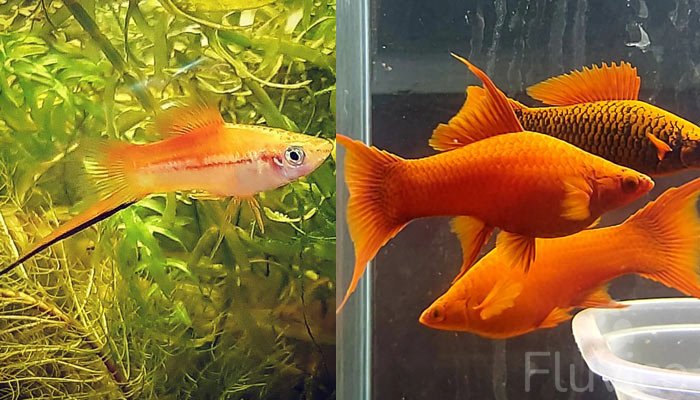
Swordtail Fish are Livebearers
Swordtail fish are livebearers, a term used in the aquarium trade to describe species that give birth to live young rather than laying eggs. This reproductive characteristic is one of the fascinating aspects of keeping Swordtail fish.
In the case of Swordtails, internal fertilisation occurs when the male uses his modified anal fin, known as a gonopodium, to deliver sperm to the female. The female then carries the fertilised eggs internally until they hatch, after which she gives birth to free-swimming fry.
The gestation period typically lasts around 28 days, although it can vary. A single female can give birth to a brood of anywhere from 20 to 100 fry, depending on her size and health. Interestingly, females can store sperm and produce multiple batches of fry from a single mating.
Live bearing lends a fascinating dynamic to the Swordtail’s behaviour, and it can be quite a spectacle to see a female Swordtail giving birth to a new generation right in your home aquarium. However, it’s important to provide the right conditions for breeding and to ensure the safety of the newborn fry, as adults can sometimes eat their young.
Aquarium Setup
Tank Size
Swordtail fish are active swimmers and require ample space to thrive. For a single Swordtail, a tank of at least 20 gallons (approximately 76 litres) is recommended. This ensures they have sufficient space for swimming and expressing natural behaviours.
If you plan to keep a group of Swordtails, the tank should be even larger. A general rule of thumb is to add an additional 10 gallons (approximately 38 litres) for each new Swordtail you introduce to the tank. For instance, a tank for two Swordtails should be around 30 gallons, while a tank for three Swordtails should be around 40 gallons.
Remember, these are minimum requirements. If you can provide a larger tank, your Swordtails will greatly appreciate it. A larger tank not only allows more room for swimming but also helps in maintaining stable water conditions, which contributes to the overall health and longevity of your fish.
It’s also worth noting that if your Swordtail fish breed, additional space will be needed to accommodate the newborn fry. So, if you plan on breeding, consider opting for a larger tank from the beginning.
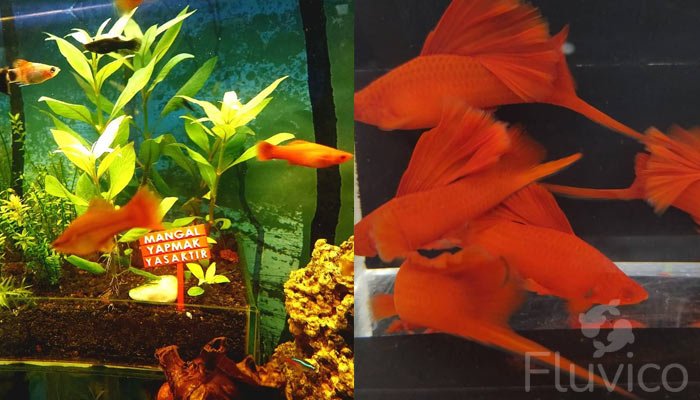
Water Parameters and Tank Conditions
Creating an environment that closely mimics the Swordtail fish’s natural habitat is key to their health and well-being. Below are the optimal water parameters and tank conditions:
- Water Temperature: Swordtail fish thrive in water temperatures between 22°C and 28°C.
- pH Level: The water should be slightly alkaline, with a pH range of 7.0 to 8.4.
- Water Hardness: Aim for general hardness (GH) between 12° and 30° dGH, which equates to moderately hard to hard water.
- Water Flow: They prefer moderate water flow that simulates their natural river habitats.
- Tank Decorations: The tank should feature plenty of hiding spots and cover, provided by live plants and rock or driftwood formations. However, ensure there’s ample open swimming space as well.
- Lighting: Moderate lighting is suitable for Swordtail fish.
- Substrate: A fine gravel or sand substrate is recommended, especially if live plants are used.
- Filtration: A high-quality filter is crucial to maintain clean water and remove waste products.
- Tank Lid: A secure lid is essential, as Swordtails are known to be good jumpers.
Remember to maintain these conditions consistently, as sudden changes can cause stress and health issues in Swordtails. Regular water changes and monitoring of water parameters will help ensure a healthy environment.
Decorations and Compatible Plants
Decorating your Swordtail fish tank properly can greatly enhance their quality of life by providing hiding spots, spawning areas, and mimicking their natural habitat. Here are some suggestions:
Decorations:
- Caves and Rocks: Swordtails appreciate places to hide and explore, so including caves or rock formations in the tank design can be beneficial.
- Driftwood: Driftwood can also serve as a hiding spot and add a natural aesthetic to the tank.
- Ceramic Pieces: Non-toxic ceramic pieces can also provide shelter and entertainment for your fish.
Compatible Plants:
Swordtails hail from environments rich in vegetation. So, incorporating live plants not only contributes to the tank’s aesthetic but also offers practical benefits like providing cover, aiding in water oxygenation, and absorbing nitrates.
- Java Fern: This hardy plant tolerates a wide range of conditions and doesn’t require substrate, as it can attach to rocks and driftwood.
- Anubias: Anubias is another robust species that can be attached to tank decorations.
- Amazon Sword: These large, leafy plants provide excellent cover and mimic the Swordtail’s natural environment. They do require a nutrient-rich substrate to thrive.
- Hornwort: A fast-growing plant that can float or be planted, excellent for providing shelter for fry.
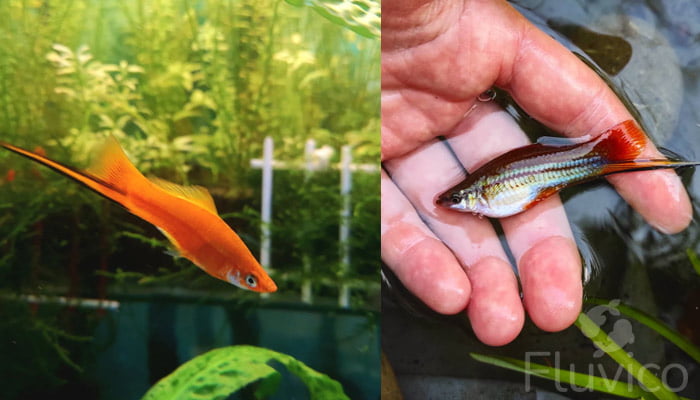
Swordtail Fish Care
Food & Diet: Feeding Your Swordtail Fish
Providing Swordtail fish with a balanced and varied diet is vital to their health, colour vibrancy, and overall well-being. They are omnivores, which means they eat both plant-based and meaty foods. Below are key points to consider when feeding Swordtail fish:
- Commercial Flakes or Pellets: High-quality commercial flakes or pellets specifically designed for tropical fish can form the basis of their diet. These foods are usually nutritionally balanced, providing the necessary proteins, carbohydrates, and vitamins.
- Live or Frozen Foods: Supplement the basic diet with live or frozen foods such as brine shrimp, daphnia, or bloodworms. These protein-rich foods can enhance growth and colour vibrancy.
- Vegetable Matter: Swordtails also need some vegetable matter in their diet. This can be provided through blanched vegetables like spinach, peas, or zucchini. Some types of algae wafers can also be used.
- Feeding Frequency: Feed your Swordtails one to two times a day, providing only as much food as they can consume in a few minutes. Overfeeding can lead to water quality issues and health problems.
- Variety: Providing a variety of food types helps ensure that the Swordtails get a range of nutrients and keeps them interested in their food.
It’s worth noting that nutritional needs can change at different life stages or during breeding, so adjustments may be needed. Always observe your fish’s behaviour and physical condition to ensure their dietary needs are being met.

Community Living: Swordtail Fish Tank Mates
When choosing tank mates for Swordtail fish, it’s important to select other peaceful species that thrive in similar water conditions. Overly aggressive or territorial fish can cause stress to Swordtails and should be avoided. Here are a few ideal tank mates for Swordtail fish:
- Mollies: They are peaceful, come in various colours and sizes, and share similar water parameter needs with Swordtails.
- Platies: Just like Swordtails, Platies are hardy and easy to care for. They get along well with Swordtails and share similar care requirements.
- Guppies: Although smaller in size, Guppies are fast swimmers and can easily cohabit with Swordtails. They’re also livebearers, sharing similar breeding behaviours.
- Certain Types of Tetras: Some Tetras, like Neon Tetras and Black Skirt Tetras, can make good tank mates due to their peaceful nature.
- Corydoras Catfish: These bottom-dwelling fish are peaceful and can help keep the tank clean by scavenging for uneaten food.
- Certain Types of Gouramis: Gouramis like the Dwarf Gourami can be suitable tank mates as long as they are not overly territorial.
- Zebra Danios: These fast-moving, peaceful fish do well with Swordtails.
It’s important to note that male Swordtails can show aggression towards each other, especially in the presence of females. It’s best to keep one male Swordtail or have a larger ratio of females to males to help reduce this aggression.
Also, bear in mind that Swordtails can interbreed with some other species like Platies, which can lead to hybrid offspring. Some aquarists might find this interesting, while others may prefer to avoid it.
Always monitor the behaviour of the fish in the tank to ensure everyone is getting along well. If you notice any signs of bullying or stress, it might be necessary to adjust the mix of fish in your tank.
Common Possible Diseases
Like all fish, Swordtails are susceptible to various diseases. While maintaining good water quality and a balanced diet can prevent most illnesses, it’s still crucial to be aware of potential health problems. Here are some common diseases that can affect Swordtail fish:
- Ich: Also known as white spot disease, ich is a parasitic infection that causes small white spots on the fish’s body and fins. It can lead to lethargy, loss of appetite, and rubbing against objects.
- Fin Rot: This bacterial disease leads to the gradual disintegration of a fish’s fins. It usually occurs due to poor water quality or if the fish’s immune system is compromised.
- Cottonmouth: Cottonmouth, or mouth fungus, is a bacterial infection that results in a cottony growth around the mouth and damages the fish’s gills and fins.
- Swim Bladder Disease: This affects the fish’s buoyancy, causing it to float on its side or upside down. It’s usually a result of a poor diet or abrupt changes in water conditions.
- Velvet: A parasitic disease causing a dust-like coating on the fish’s body, loss of appetite, and increased respiration.
If you notice any signs of disease, it’s important to diagnose the problem accurately and start the appropriate treatment promptly. Many fish diseases are contagious, so it’s crucial to isolate the sick fish in a separate hospital tank to prevent the illness from spreading. Always consult a vet or a fish health expert for proper diagnosis and treatment.
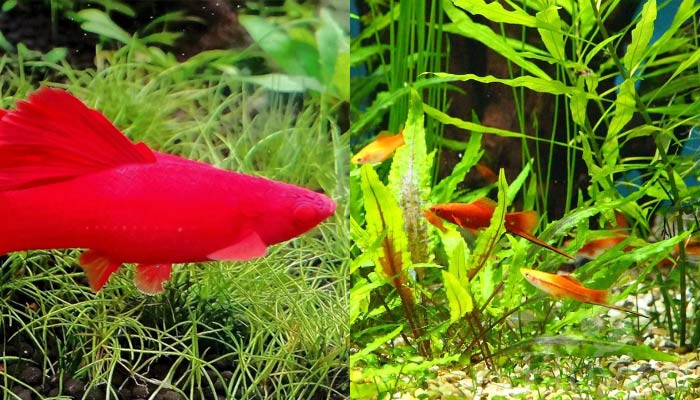
Breeding Swordtail Fish
Breeding Swordtail fish can be an interesting and rewarding experience. Here are the general steps involved:
6-8 weeks
Step 1: Determine the Sexes
Identify male and female Swordtails in your tank. Males have a long, sword-like tail and a modified anal fin called a gonopodium. Females have rounder bodies and lack the prominent ‘sword.’
Step 2: Setting Up the Breeding Tank
Prepare a separate breeding tank with the same water parameters as the main tank. It should have plenty of hiding spots and live plants, offering cover for the fry.
Step 3: Choose the Breeders
Select healthy adult Swordtails for breeding. Ideally, keep a ratio of one male to at least two or three females to prevent a single female from being harassed excessively.
Step 4: Feeding
Feed the breeding Swordtails a diet rich in protein, such as brine shrimp and daphnia, to condition them for breeding.
Step 5: Spawning
Males will chase females to mate. After successful mating, the female will carry the fertilised eggs and give birth to live fry after about 28 days.
Step 6: Separation
Once you notice that the female is about to give birth (her abdomen will look boxy and enlarged), you may wish to move her to the breeding tank if not already done. This is to protect the newborn fry from being eaten by other fish in the main tank.
Step 7: Birth
The female will give birth to live fry. This can be a few or up to 100, depending on her size and health.
Step 8: Post-Birth Care
After birth, remove the mother from the breeding tank to prevent her from eating the fry. Feed the fry a diet of infusoria or commercial fry food until they are large enough to eat regular food.
Step 9: Raising the Fry
Once the fry are big enough (usually after a month), you can gradually introduce them to the main tank or a larger grow-out tank.
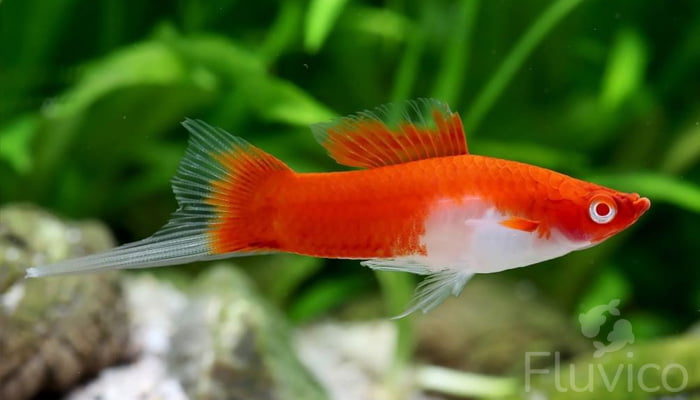
Should You Get a Swordtail Fish for Your Aquarium
Deciding whether to introduce Swordtail fish to your aquarium requires considering various factors. Here’s a summarised breakdown of the benefits and potential drawbacks of Swordtail fish ownership:
Benefits:
- Suitability: Swordtail fish are hardy and adaptable, making them suitable for both beginner and experienced aquarists.
- Visual Appeal: Their vibrant colours and distinctive ‘sword-like’ tail add a visual appeal to any aquarium.
- Behaviour: Swordtails are active and engaging, contributing to a lively aquarium dynamic.
- Breeding: As livebearers, they provide an exciting opportunity to observe fish birth and raise the young, adding another dimension to the fish-keeping hobby.
- Community Living: They are generally peaceful and can cohabit well with various other non-aggressive species, making them an excellent choice for community tanks.
Drawbacks:
- Tank Size Requirement: Swordtails are active swimmers and require a spacious tank, so they might not be suitable if you have limited space.
- Care Requirements: Like all fish, Swordtails need regular care, including a balanced diet and specific water conditions to thrive.
- Potential Aggression: Male Swordtails can sometimes show aggression towards each other, especially in the presence of females.
In summary, Swordtail fish can be a fantastic addition to your aquarium if you’re prepared for the regular tank maintenance, can provide an adequately sized aquarium, and appreciate active, visually appealing fish. However, potential drawbacks such as the need for significant swimming space and some care requirements should also be factored into the decision.
FAQ
Can Swordtails live with other fish?
Yes, Swordtail fish are generally peaceful and can cohabit well with various other non-aggressive, similarly-sized species, making them an excellent choice for community aquariums. Always ensure compatibility to maintain a harmonious tank environment.
Do Swordtails eat Guppies?
While Swordtails are generally peaceful, they might prey on smaller fish if they are hungry enough. However, they don’t specifically target guppies. To prevent such incidents, ensure all fish in the tank are well-fed and appropriately sized.
Can Swordtails be kept in pairs?
Yes, Swordtails can be kept in pairs. However, to prevent a single female from being harassed by the male, it’s usually recommended to keep one male with multiple females, typically in a ratio of 1:2 or 1:3.
Do Swordtails jump?
Yes, Swordtail fish are known to be good jumpers. They may leap out of the tank, particularly if stressed or startled. Therefore, it’s advisable to have a secure lid on your aquarium.
Why is my Swordtail Fish hiding?
Swordtail fish may hide due to stress, which can stem from factors such as poor water conditions, illness, aggressive tank mates, changes in their environment, or lack of adequate hiding spaces in the tank.
More Reading

15 Types of Cryptocoryne: Which is Best For Your Aquarium Setup?

16 Awesome Low Light Aquarium Plants (Mosses, Ferns & Stem Plants)


18 Types of Aquarium Moss: Photos, Care, Propagation & Growth Guide

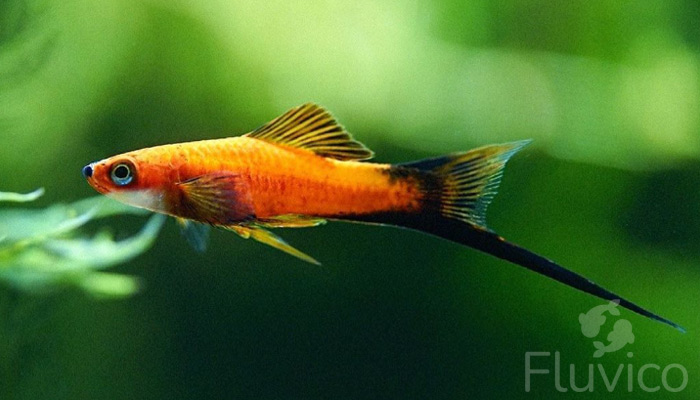

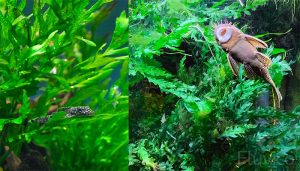



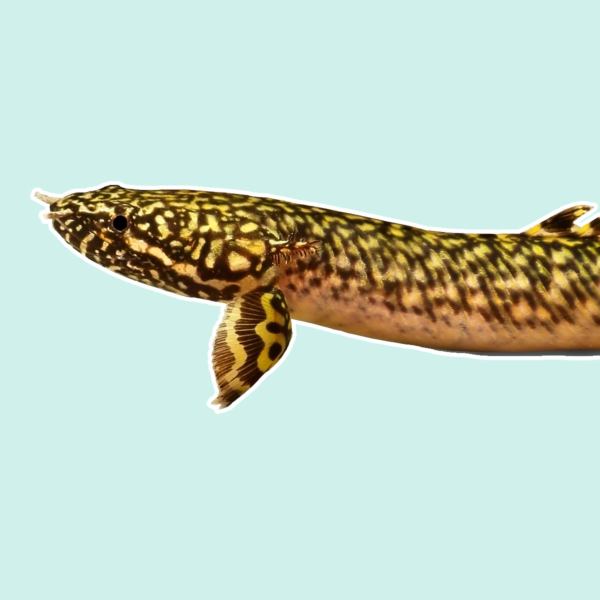
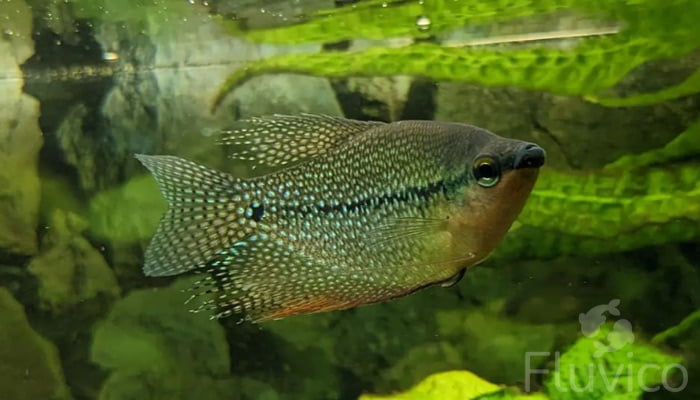


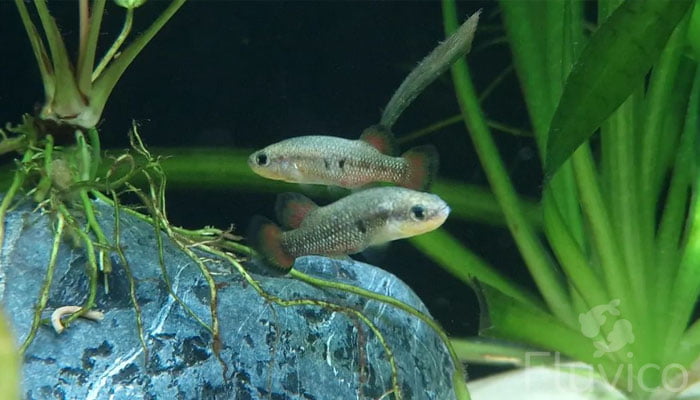
Hope you enjoyed our Swordtail fish Care Guide!
If you have any questions? Ask away, we’re here to help!
All the best,
Daniel